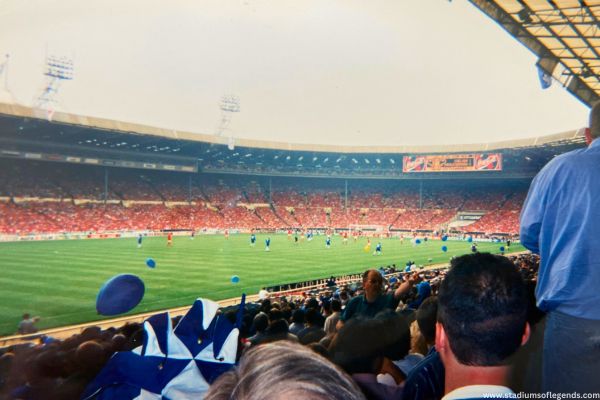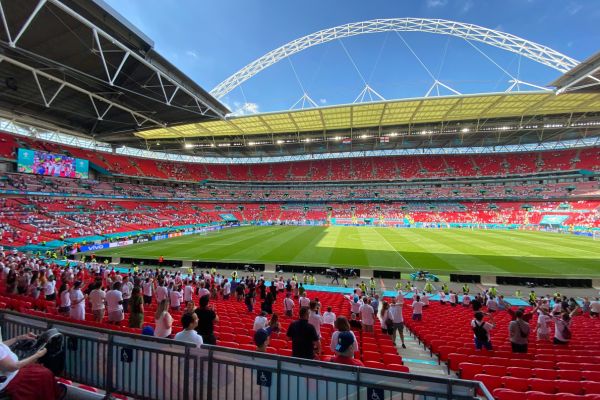A soaked Kevin Keegan walked toward the players’ tunnel, rain pouring down inside a packed Wembley Stadium. As he reached the tunnel, positioned behind the goal at the far end of the pitch, press cameras tracking his every move. Then, for a brief moment, he glances back, one last look at the stadium he had graced so many times.
It was October 7, 2000, the final game at the old Wembley. England had hoped to give the stadium a proper send-off, but instead, they suffered a frustrating 1-0 defeat to their old rivals, Germany in a World Cup Qualifier. Keegan, a legend as a player, now England’s manager, feeling the weight of the loss more than anyone.
The rain kept falling, as if the heavens themselves were mourning the farewell of a footballing temple. Over the next few years, the old Wembley would be demolished, making way for a new, grand cathedral of football.
As for England? Keegan resigned that very night. But just a year later, under new manager Sven-Göran Eriksson, they would get their revenge thrashing Germany 5-1 in Munich.
The Birth of an Icon
Before Wembley, FA Cup finals were held at various venues, including The Oval Cricket Ground and Crystal Palace Park. That changed in 1923, when the original Wembley Stadium, complete with its famous Twin Towers, was built as part of the British Empire Exhibition. Originally meant to be demolished after the exhibition, it was saved and went on to become the stage for some of football’s most unforgettable moments.
A Stage for History

Wembley has seen it all. The triumphs, the heartbreaks, the unforgettable performances that have shaped football history.
The "White Horse" Final (1923) – The first FA Cup final at Wembley, where a single mounted policeman controlled a crowd of over 200,000.
Olympics – Hosted the 1948 London Games, bringing post-war hope to a battered nation.
The Matthews Final (1953) – Sir Stanley Matthews led Blackpool to a legendary comeback in what many call the greatest FA Cup Final ever.
Manchester United’s European Glory (1968) – United became the first English club to win the European Cup, defeating Benfica under the Wembley lights.
1966 World Cup Final – England's greatest footballing triumph, with Geoff Hurst’s controversial "goal over the line" sealing victory over West Germany.
European Cup/Champions League Finals – From Borussia Dortmund’s heartbreak against Real Madrid and Bayern Munich to Barcelona’s tiki-taka masterclasses, Wembley has played host to club football’s greatest night.
Live Aid (1985) – The stage where Queen delivered one of the greatest live performances of all time.
The End of an Era
By the late 1990s, the original Wembley was showing its age. In 2000, England played their last match there losing to Germany, of all teams. The stadium was then demolished, a slow and painful process that took years. Gone were the Twin Towers, deemed too difficult to reconstruct. In their place, the new Wembley would rise, but with a different identity.
A New Wembley, A New Legacy

In 2007, the new Wembley Stadium was unveiled. While it occupies almost the same site as its predecessor, it boasts a modern design, with the towering 133-meter-high arch replacing the old Twin Towers. This arch is visible for miles and now lights up in the colours of teams playing or the winning team of a final.
Middlesbrough’s Hidden Mark
It’s said that Middlesbrough fans working on the stadium’s construction stuffed Boro shirts into the arch’s frame, forever leaving their mark on Wembley!
With a 90,000-seat capacity, Wembley remains the largest stadium in the UK, hosting England’s home games, the FA Cup semi-finals and final, the League Cup final, and the Championship play-off final, dubbed "the richest game in football" due to the financial rewards of promotion to the Premier League.
Wembley Way: A Walk Through Time
For generations, fans have made the pilgrimage down Wembley Way, the famous walkway leading from the station to the stadium. Over the years, the landscape has changed. Modern buildings now line the route, and the old ramp leading to the stadium, once covered in graffiti from visiting fans, has been replaced with steps.
Old vs. New: A Personal Reflection
Having experienced both the old and new Wembley, opinions remain divided. The old stadium, despite its distance from the pitch, had a sense of history and grandeur that’s hard to replicate. The new Wembley is impressive, modern, and enormous. But for some, perhaps too big. If you’re seated high up, the action can feel distant, almost detached. In my view, 70,000 seats would have been the perfect size, but as with everything in football, opinions will always differ.
As Wembley approaches 20 years since its grand reopening, it continues to build its own history. New finals, new moments, new legends. One thing remains unchanged: Wembley is still the place where football dreams come true.
Why is Wembley a Legendary Stadium
Wembley Stadium isn’t just England’s national stadium, it’s a sacred ground in the footballing world. Known as The Cathedral of Football, it stands as a symbol of the country that gave the world the beautiful game. Even without a ball being kicked, Wembley carries an unmatched aura, a place where legends are made, dreams are fulfilled, and history is written.
But what makes Wembley more special than any other stadium? Yes, it’s the home of English football, but its long and storied history is what truly sets it apart.
